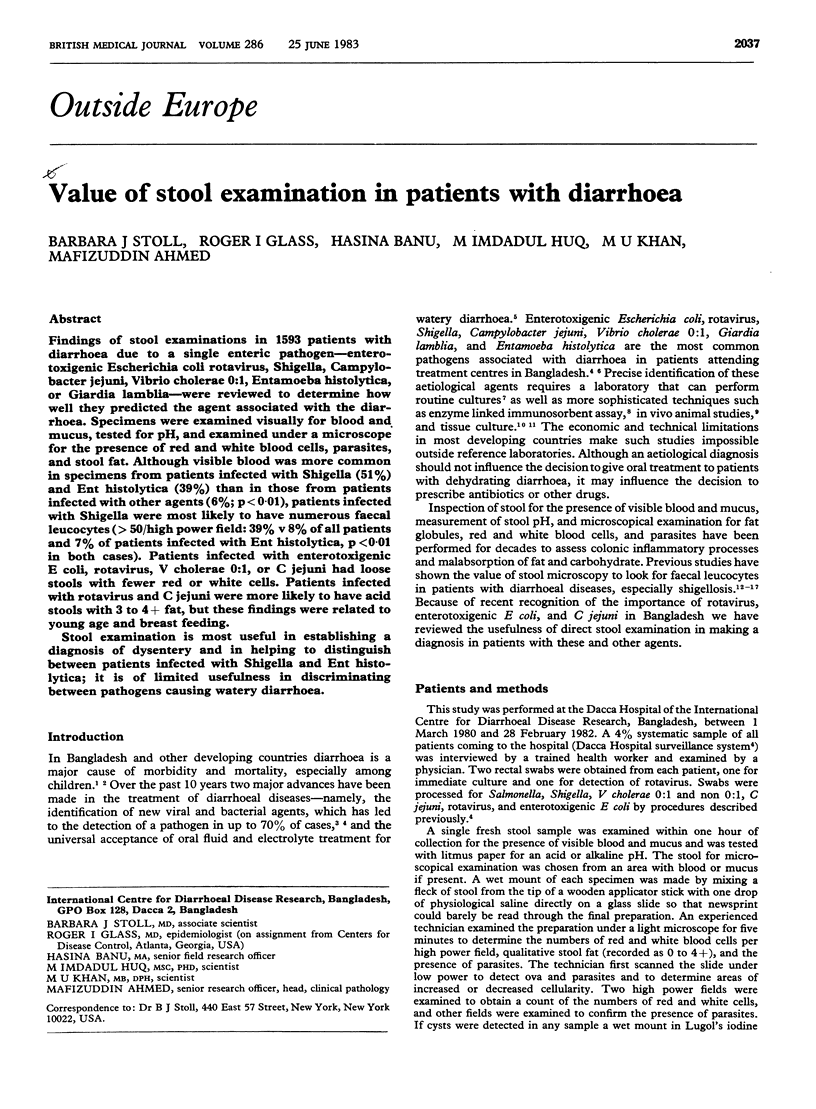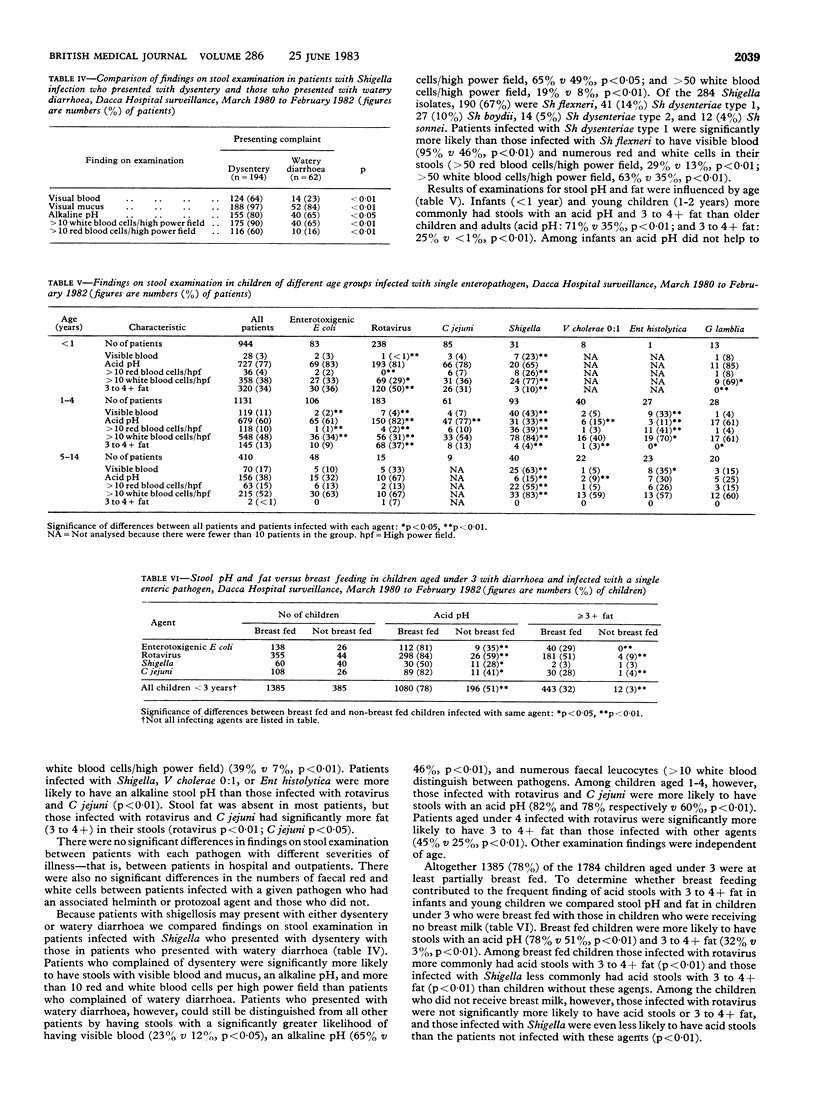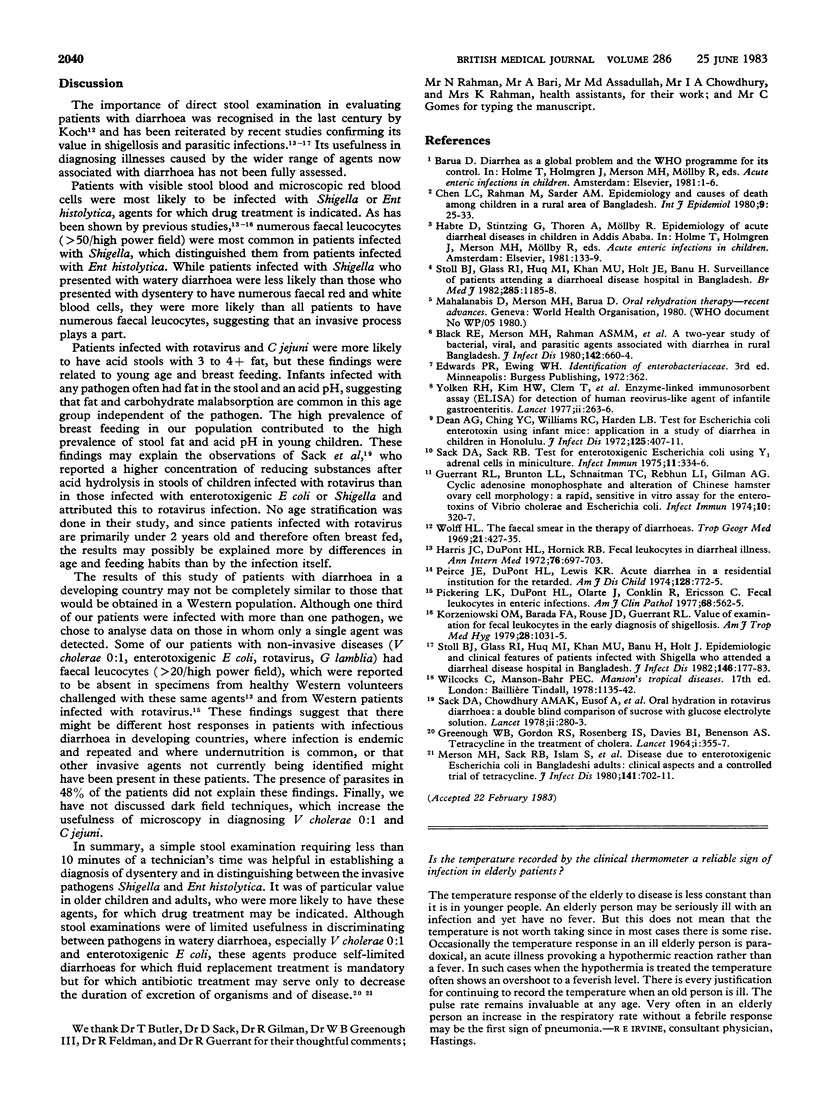Abstract
Findings of stool examinations in 1593 patients with diarrhoea due to a single enteric pathogen--enterotoxigenic Escherichia coli rotavirus, Shigella, Campylobacter jejuni, Vibrio cholerae 0:1, Entamoeba histolytica, or Giardia lamblia--were reviewed to determine how well they predicted the agent associated with the diarrhoea. Specimens were examined visually for blood and mucus, tested for pH, and examined under a microscope for the presence of red and white blood cells, parasites, and stool fat. Although visible blood was more common in specimens from patients infected with Shigella (51%) and Ent histolytica (39%) than in those from patients infected with other agents (6%; p less than 0.01), patients infected with Shigella were most likely to have numerous faecal leucocytes (greater than 50/high power field: 39% v 8% of all patients and 7% of patients infected with Ent histolytica, p less than 0.01 in both cases). Patients infected with enterotoxigenic E coli, rotavirus, V cholerae 0:1, or C jejuni had loose stools with fewer red or white cells. Patients infected with rotavirus and C jejuni were more likely to have acid stools with 3 to 4+ fat, but these findings were related to young age and breast feeding. Stool examination is most useful in establishing a diagnosis of dysentery and in helping to distinguish between patients infected with Shigella and Ent histolytica; it is of limited usefulness in discriminating between pathogens causing watery diarrhoea.
Full text
PDF



Selected References
These references are in PubMed. This may not be the complete list of references from this article.
- Black R. E., Merson M. H., Rahman A. S., Yunus M., Alim A. R., Huq I., Yolken R. H., Curlin G. T. A two-year study of bacterial, viral, and parasitic agents associated with diarrhea in rural Bangladesh. J Infect Dis. 1980 Nov;142(5):660–664. doi: 10.1093/infdis/142.5.660. [DOI] [PMC free article] [PubMed] [Google Scholar]
- Chen L. C., Rahman M., Sarder A. M. Epidemiology and causes of death among children in a rural area of Bangladesh. Int J Epidemiol. 1980 Mar;9(1):25–33. doi: 10.1093/ije/9.1.25. [DOI] [PubMed] [Google Scholar]
- Dean A. G., Ching Y. C., Williams R. G., Harden L. B. Test for Escherichia coli enterotoxin using infant mice: application in a study of diarrhea in children in Honolulu. J Infect Dis. 1972 Apr;125(4):407–411. doi: 10.1093/infdis/125.4.407. [DOI] [PubMed] [Google Scholar]
- GREENOUGH W. B., 3rd, GORDON R. S., Jr, ROSENBERG I. S., DAVIES B. I., BENENSON A. S. TETRACYCLINE IN THE TREATMENT OF CHOLERA. Lancet. 1964 Feb 15;1(7329):355–357. doi: 10.1016/s0140-6736(64)92099-9. [DOI] [PubMed] [Google Scholar]
- Guerrant R. L., Brunton L. L., Schnaitman T. C., Rebhun L. I., Gilman A. G. Cyclic adenosine monophosphate and alteration of Chinese hamster ovary cell morphology: a rapid, sensitive in vitro assay for the enterotoxins of Vibrio cholerae and Escherichia coli. Infect Immun. 1974 Aug;10(2):320–327. doi: 10.1128/iai.10.2.320-327.1974. [DOI] [PMC free article] [PubMed] [Google Scholar]
- Harris J. C., Dupont H. L., Hornick R. B. Fecal leukocytes in diarrheal illness. Ann Intern Med. 1972 May;76(5):697–703. doi: 10.7326/0003-4819-76-5-697. [DOI] [PubMed] [Google Scholar]
- Korzeniowski O. M., Barada F. A., Rouse J. D., Guerrant R. L. Value of examination for fecal leukocytes in the early diagnosis of shigellosis. Am J Trop Med Hyg. 1979 Nov;28(6):1031–1035. doi: 10.4269/ajtmh.1979.28.1031. [DOI] [PubMed] [Google Scholar]
- Merson M. H., Sack R. B., Islam S., Saklayen G., Huda N., Huq I., Zulich A. W., Yolken R. H., Kapikian A. Z. Disease due to enterotoxigenic Escherichia coli in Bangladeshi adults: clinical aspects and a controlled trial of tetracycline. J Infect Dis. 1980 Jun;141(6):702–711. doi: 10.1093/infdis/141.6.702. [DOI] [PubMed] [Google Scholar]
- Peirce J. E., DuPont H. L., Lewis K. R. Acute diarrhea in a residential institution for the retarded: usefulness of fecal leukocyte examination. Am J Dis Child. 1974 Dec;128(6):772–775. doi: 10.1001/archpedi.1974.02110310020004. [DOI] [PubMed] [Google Scholar]
- Pickering L. K., DuPont H. L., Olarte J., Conklin R., Ericsson C. Fecal leukocytes in enteric infections. Am J Clin Pathol. 1977 Nov;68(5):562–565. doi: 10.1093/ajcp/68.5.562. [DOI] [PubMed] [Google Scholar]
- Sack D. A., Chowdhury A. M., Eusof A., Ali M. A., Merson M. H., Islam S., Black R. E., Brown K. H. Oral hydration rotavirus diarrhoea: a double blind comparison of sucrose with glucose electrolyte solution. Lancet. 1978 Aug 5;2(8084):280–283. doi: 10.1016/s0140-6736(78)91687-2. [DOI] [PubMed] [Google Scholar]
- Sack D. A., Sack R. B. Test for enterotoxigenic Escherichia coli using Y-1 adrenal cells in miniculture. Infect Immun. 1975 Feb;11(2):334–336. doi: 10.1128/iai.11.2.334-336.1975. [DOI] [PMC free article] [PubMed] [Google Scholar]
- Stoll B. J., Glass R. I., Huq M. I., Khan M. U., Banu H., Holt J. Epidemiologic and clinical features of patients infected with Shigella who attended a diarrheal disease hospital in Bangladesh. J Infect Dis. 1982 Aug;146(2):177–183. doi: 10.1093/infdis/146.2.177. [DOI] [PubMed] [Google Scholar]
- Stoll B. J., Glass R. I., Huq M. I., Khan M. U., Holt J. E., Banu H. Surveillance of patients attending a diarrhoeal disease hospital in Bangladesh. Br Med J (Clin Res Ed) 1982 Oct 23;285(6349):1185–1188. doi: 10.1136/bmj.285.6349.1185. [DOI] [PMC free article] [PubMed] [Google Scholar]
- Wolff H. L. The faecal smear in the therapy of diarrhoeas. Trop Geogr Med. 1969 Dec;21(4):427–435. [PubMed] [Google Scholar]
- Yolken R. H., Kim H. W., Clem T., Wyatt R. G., Kalica A. R., Chanock R. M., Kapikian A. Z. Enzyme-linked immunosorbent assay (ELISA) for detection of human reovirus-like agent of infantile gastroenteritis. Lancet. 1977 Aug 6;2(8032):263–267. doi: 10.1016/s0140-6736(77)90951-5. [DOI] [PubMed] [Google Scholar]


